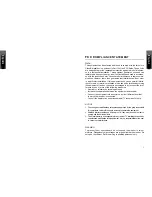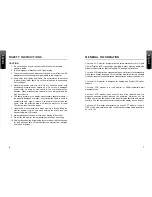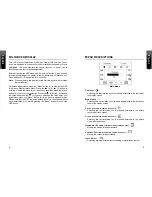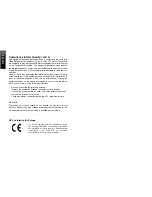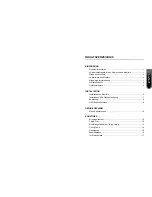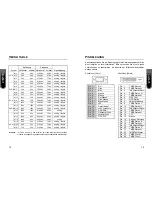
T
IMING
G
UIDE
Timing Table
Resolution
Frequency
Preset
Horizontal Vertical Horizontal Vertical
signal input
M1
640
480
31.5kHz
60Hz
analog / digital
VGA
M2
640
480
35.0kHz
67Hz
analog / digital
M3
640
480
37.5kHz
75Hz
analog / digital
M4
640
480
37.9kHz
73Hz
analog / digital
M5
800
600
37.9kHz
60Hz
analog / digital
M6
800
600
46.9kHz
75Hz
analog / digital
SVGA M7
800
600
35.2kHz
56Hz
analog / digital
M8
800
600
48.0kHz
72Hz
analog / digital
M9
832
624
49.7kHz
75Hz
analog / digital
M10
1024
768
48.4kHz
60Hz
analog / digital
XGA
M11
1024
768
56.5kHz
70Hz
analog / digital
M12
1024
768
60.0kHz
75Hz
analog / digital
M13
1280
1024
64.0kHz
60Hz
analog / digital
SXGA M14
1280
1024
80.0kHz
75Hz
analog / digital
M15
1280
1024
91.2kHz
85Hz
analog
M16
1152
864
80.0kHz
75Hz
analog / digital
M17
1280
960
60.0kHz
60Hz
analog / digital
M18
1280
960
85.9kHz
85Hz
analog
M19
640
400
31.5kHz
70Hz
analog / digital
DOS
M20
640
350
31.5kHz
70Hz
analog / digital
M21
720
400
31.5kHz
70Hz
analog / digital
T
IMING
G
UIDE
The LCD is a multi-frequency display. On analog input it operates at
horizontal frequencies between 24KHz - 93KHz and vertical frequencies
between 55Hz - 85Hz; on digital input it operates at horizontal frequencies
between 24KHz - 83KHz and vertical frequencies between 55Hz - 85Hz
Because of its microprocessor-based design, it offers auto-
synchronization and auto-sizing capabilities. This monitor offers 21 pre-
programmed settings that are listed in the timing table on page 13.
These preset modes cover most of the common video modes supported
by popular graphics adapters. However, each adapter’s implementation of
these video modes may vary slightly. If you find it necessary to make
minor display adjustments (for example, horizontal and vertical position).
Please refer to the On Screen Display section of this manual for
instructions.
If you would like to use one of the preset timing modes, please refer to
your video card manufacturer’s installation guide for instructions on how
to make these changes. The video card controls the refresh rate. Most
video cards provide a software utility or hardware DIP switches that allows
you to change the frequency used for each resolution.
12
13



